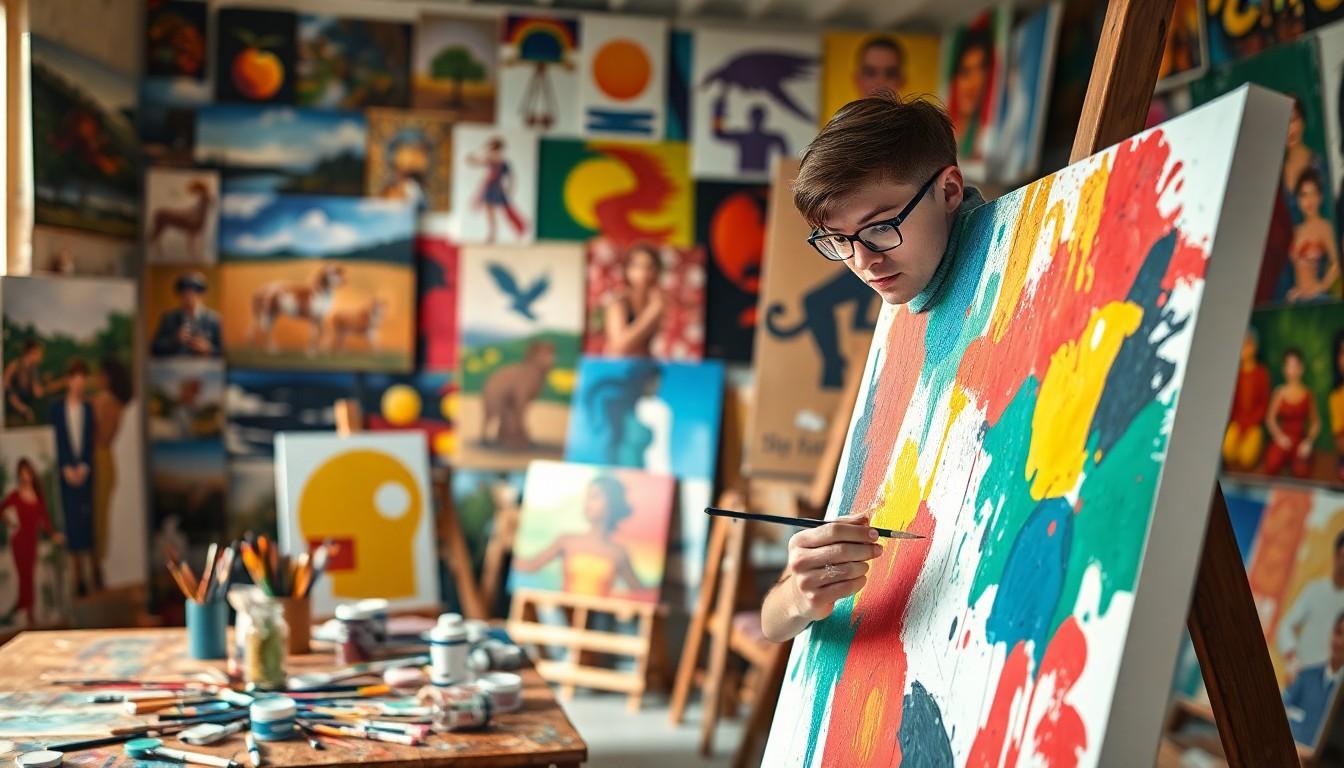Art is like a buffet for the soul, offering a delightful spread of styles that can tickle anyone’s fancy. From the whimsical strokes of cartooning to the intricate details of realism, each art style has its own flavor. Whether someone’s doodling in a notebook or crafting a masterpiece, the world of drawing is bursting with possibilities that can spark creativity and inspire.
Types of Art Styles Drawing
Art styles encompass various techniques and themes, showcasing the tremendous diversity in artistic expression. Each style invites artists to explore and convey their vision in distinct ways.
Realism captures subjects lifelike, focusing on intricate details and accurate portrayals. This approach seeks to represent the world as it is, ensuring viewers connect with the visual representation.
Impressionism emphasizes light and color, often conveying a moment in time. Artists like Claude Monet exemplified this style by using quick brush strokes to evoke emotion and atmosphere.
Expressionism aims to express inner feelings rather than depicting reality. Through bold colors and exaggerated forms, it captures the emotional state of the artist, allowing viewers to experience art on a deeper level.
Surrealism blurs the line between reality and dreams, presenting bizarre yet thought-provoking images. Artists such as Salvador Dalí challenge perception, inviting viewers into their imaginative worlds.
Abstract art focuses on shapes, colors, and forms, often disregarding realistic representation. This style encourages interpretation, allowing viewers to derive personal meaning and emotional responses.
Cartooning, characterized by exaggerated features and whimsical narratives, appeals to a broad audience. This style often carries humor or social commentary and serves to entertain or provoke thought.
Each art style holds unique attributes that resonate with different audiences. Various techniques cater to artists’ emotions, experiences, and visions, fostering creativity and exploration. Embracing these diverse styles opens up new avenues for expression and inspiration within the art community.
Realism
Realism emphasizes depicting subjects accurately and truthfully. This art style seeks to represent life as it realistically appears, avoiding stylization and idealization.
Characteristics
Realism features meticulous attention to detail. Artists often portray ordinary scenes and everyday life, presenting familiar subjects. Human figures appear natural, with accurate proportions and expressions. Color palettes remain true to life, featuring muted tones instead of vivid hues. Light and shadow play crucial roles, enhancing depth and dimension. This approach to drawing evokes emotional responses through relatable scenarios.
Techniques
Artists employ several techniques to achieve realism. Observational skills are vital, as artists study their subjects closely. Layering techniques often enhance texture and depth, creating a three-dimensional effect. Use of glazing and underpainting builds complexity in color and form. Additionally, artists utilize a variety of materials, including graphite, charcoal, and oil paints, to achieve desired effects. Mastery of techniques like chiaroscuro can provide dramatic contrasts and enhance overall realism.
Impressionism
Impressionism focuses on capturing a moment through light and color, often emphasizing the visual impression of a scene rather than fine details. Artists seek to convey emotions and sensory experiences through their work.
Key Features
Impressionism features loose brushwork, which creates a sense of movement. Color palettes include vibrant hues, often applied side by side rather than blended. Light plays a crucial role, highlighting effects through varying times of day and weather conditions. Subjects frequently depict landscapes, urban scenes, and everyday life, reflecting spontaneous moments. Artists embrace outdoor painting, known as plein air, to capture natural light. This art style also invites viewer interpretation, relying on individual perception of color and form.
Famous Artists
Claude Monet stands as a pioneer of Impressionism, celebrated for his series on water lilies and haystacks. Pierre-Auguste Renoir captures joyful moments with a focus on people in social settings. Edgar Degas, known for his unique portrayals of dancers, explores movement and composition. Camille Pissarro contributes to urban scenes, highlighting everyday life. Berthe Morisot breaks from traditional confines, emphasizing women’s experiences and perspectives. Each artist plays a role in defining and expanding the Impressionist movement, solidifying its place in art history.
Abstract Art
Abstract art encourages individuals to interpret shapes and colors personally. It focuses on the expressive qualities of visual elements rather than representational accuracy.
Definitions
Abstract art refers to artwork that distills primary forms and colors to convey concepts. This style breaks away from traditional representation, aiming to evoke emotions rather than depict reality. Many artists utilize abstraction to explore feelings, ideas, or sensations, allowing viewers to find meaning based on personal perspectives. Notable movements within abstract art include Abstract Expressionism, which emphasizes spontaneous and instinctual creation, and Geometric Abstraction, where shapes and lines form the composition.
Expressive Techniques
Expressive techniques in abstract art involve various methods that highlight emotion and interpretation. Artists often utilize bold color palettes to provoke emotional responses, opting for dynamic brush strokes that create energy. Additionally, layering materials adds depth and texture, enhancing the viewer’s experience. Non-traditional mediums, such as digital tools and mixed media, frequently feature in modern abstract practices. Collage techniques enable the combination of different materials, fostering unique visual outcomes. Through these techniques, abstract artists invite exploration and connection to their work.
Surrealism
Surrealism captivates audiences through its dreamlike imagery and unexpected juxtapositions. This art style often challenges perceptions and blurs the line between reality and fantasy.
Themes
Surrealist themes explore the unconscious mind, dreams, and the irrational aspects of life. Artists frequently draw inspiration from dreams, using bizarre scenes to evoke emotional responses. The exploration of everyday objects in unusual contexts highlights the absurdity of reality. Transformation, surprise, and nonconformity also serve as central elements, inviting viewers to engage with their imagination. Surrealism encourages reflection on the complexities of human existence and emotions, delivering a rich tapestry of meaning.
Notable Works
Notable works within the Surrealist movement showcase innovative techniques and striking visuals. Salvador Dalí’s “The Persistence of Memory” illustrates melting clocks in a dreamlike landscape, prompting thoughts on time and reality. René Magritte’s “The Treachery of Images” features the famous phrase “This is not a pipe,” challenging viewers’ perceptions of representation. Max Ernst’s “The Elephant Celebes” combines fantastical elements with real-life subjects, creating a sense of intrigue. Each piece reinforces the movement’s goal of distorting reality, leading to unique interpretations and emotional engagement.
Diverse Tastes and Emotions
Art styles in drawing offer a vibrant spectrum of expression that caters to diverse tastes and emotions. Each style invites artists and viewers alike to explore their creativity and connect with the world around them. Whether one is drawn to the lifelike details of realism or the imaginative realms of surrealism, there’s a style that resonates deeply.
As artists experiment with various techniques and themes, they contribute to an ever-evolving landscape of artistic expression. This journey not only enriches their skills but also fosters a deeper appreciation for the art community and its myriad forms. Embracing different styles can inspire both personal growth and a broader understanding of the human experience through art.


